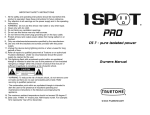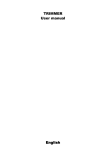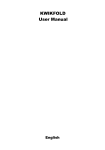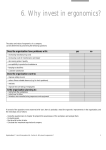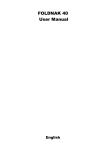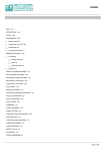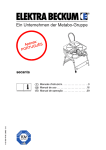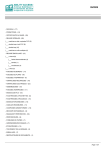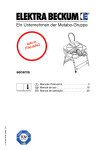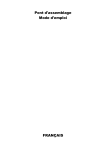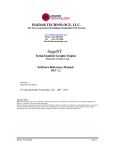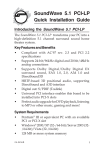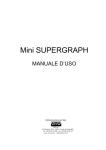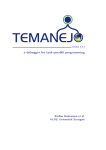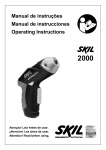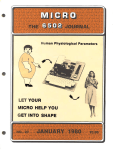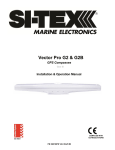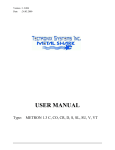Download English CITOBORMA 490 User manual
Transcript
CITOBORMA 490 User manual English Contents Contents .........................................................................................................................2 General view ..................................................................................................................3 Safety and cautionary notes...........................................................................................4 Setting up .......................................................................................................................4 Sense of rotation of the drill bit motor ..........................................................................4 Drill bit diameters ..........................................................................................................5 Changing the drill bit and reducer (standard drill head 45mm wide only)...................5 Changing of the drill bits...............................................................................................6 Drill bit speed ................................................................................................................7 Variable drill bit and table lift speed.............................................................................7 Moving sideways a head................................................................................................8 Removing a head ...........................................................................................................8 Adding a head ................................................................................................................9 Drill bit depth...............................................................................................................10 Depth adjustment .........................................................................................................11 Back fence....................................................................................................................12 Side stop.......................................................................................................................13 Lubrication (Option)....................................................................................................14 Drilling.........................................................................................................................15 Recommended options.................................................................................................16 Maintenance.................................................................................................................17 Faults............................................................................................................................18 Technical data ..............................................................................................................18 Wiring diagramm (Basis) ............................................................................................20 Wiring diagramm (Vario) ............................................................................................22 Declaration of conformity ...........................................................................................23 2 General view 1. Speed switch 2. Drill head 3. Safety cover The machine shuts off when opening the safety cover. 4. Two-hand release Push the green release buttons simultaneously to cycle. 5. Side stop 6. Main switch Emergency switch 7. Foot pedal socket 8. Levelling foot 9. Tool case 10. Back fence handwheel 11. Table heighth handwheel 12. Back fence 3 Safety and cautionary notes Use original Nagel parts only for any repairs. Unplug the power cord for any repairs. Repairs and any other work on the drill should only be carried out by an approved service engineer. Safety devices must not be taken off or disabled. Never operate the machine when damaged (damaged power cord etc.). Drill paper and cardboard only. Never reach into the working area when the table or drill bits are moving. Install the power cord out of the way to avoid tripping over it. Work place of the operator: in front of the machine. Install the machine in a dry work shop. Setting up Set up machine on a firm, level surface facing the operator and plug in the mains plug. Put the drill in place and level it with the levelling foot (8). Sense of rotation of the drill bit motor Check the sense of rotation of the drill bit motor before starting to work for the first time. If the drill bits turn opposite to the direction indicated by the arrow then switch the position of any two out of the three current wires in the three phase plug of the machine. But never touch the neutral wire (marked „N“) or the earth wire (yellowgreen). 4 Drill bit diameters Head BK 32 BK 45 BK 125 Trio Filofax Filofax 6 Drill- / mm 2-9 2-14 15-35 2-6 2-6 2-6 Changing the drill bit and reducer (standard drill head 45mm wide only) To take out the drill bit and the reduction collet (27) use a 4mm allen key (24) to turn the screw (26) counterclockwise. Excert just as much twist as to open up the slot in the spindle (25) a tiny bit. This will allow the drill bit and reduction collet to come out easily. You may screw the bolt (28) from the accessories bag into the reduction collet if necessary. No reduction collect needed for drill bit diametes from 10-14mm. 5 Changing of the drill bits Open up the safety cover (3). Insert paper drill into the drilling spindle (76) up to the stop and tighten up with the Allan key (24). Important: When pushing-in the reduction sleeve (77) and the drill (78), take care that paper dust and drilling waste are removed completely. If the drill (78) is not clamped correctly or not pushed right up as far as it will go, a gap remains between the reduction sleeve (77) and the drill (78) (see arrow). Paper dust and drilling waste collect in this gap. This can lead to clogging of the reduction sleeve (77). If the reduction sleeve (77) is clogged, the paper cuttings cannot move away and the drill (78) will break. When this has happened, the reduction sleeve (77) must be taken out of the drilling spindle (76) and cleaned thoroughly. 6 Drill bit speed Head Head 32 Head 45 Head 125 Drill-& / mm Trio Filofax Filofax 6 Speed switch (1) Position 1= 1890 1/min N/A (Position 2= 950 1/min) Position 2= 1890 1/min Position 1= 550 1/min Position 2 = 1100 1/min 21-35 15-20 Position 2 Position 2 Position 2 Vario Poti (29) Min-Max 1510-(3436) 755-1718 550-1260 However, it may be necessary to ignore this rule of thumb, especially when working with diameters smaller than 4 mm or wider than 10 mm. The smaller the diameter the faster the drill bit may turn and vice versa. Variable drill bit and table lift speed If your Citoborma is equipped with this option use the upper knob (29) to control the drill bit speed and the lower knob (30) to control the table lift speed. (Min = 8 strokes/min, max. = 19 strokes/min) The machine with variable speed has no speed switch (1). The variable speed option allows to drill special papers, coated stock or plastic. The results for these jobs can be further improved with the optional air cooling of the drill bits. Important! Allow the machine to rest for 30 seconds before starting the main switch again. This is only necessary for the models offering variable drill bit and table lift speed. 7 Moving sideways a head Loosen the fixing screw (41) lightly to move the head sideways. The scale above the heads helps finding the desired position. The zero indicates the centre of the machine. Removing a head Turn off the main switch. Open the screw (31) the small cover plate (33). Take out the fixing screw (32) with a 4 mm allen key. Pull out the splined shaft (34) as far as needed. Screw the grip from the accessories bag (35) onto the shaft to pull the shaft out easily. Pull off the air cooling tube from the distributing block by pressing the blue ring. The black pins (enclosed with the accessories) can be placed upon the distribution block instead of the air cooling tube (this can only be done when having a machine which is established with the air cooling system). Turn the fixing screw (41) completely up and take the head out towards yourself. 8 Adding a head Turn the fixing screw (41) completely up. Lift the head onto the support bar taking care that it rests well against the support bar. The right picture shows an incorrectly inserted head. Tighten the fixing screw firmly. Play with the splined shaft by turning it when pushing it back through the heads in case the gear taking up the shaft has lost the correct position. Do not forget putting back in the fixing screw (32) onto the shaft with a 4 mm allen key. correct incorrect 9 Drill bit depth Always pay attention to the following. After every drill change and whenever the proper drilling depth setting is not known, take the precaution to turn the drilling table right to the bottom with the handwheel (11). Otherwise there is a danger that the table stroke is too large so that the drills penetrate the work table and break. Knurled screw (39) for locking the handwheel (11). Place the drilling cardboard (79) on the drilling table as drilling underlay. Place the adjusting gauge (78) under the drill (23) which stands lowest. Move the drilling table upwards with the handwheel (11) until the adjusting gauge lightly contacts the drill. Take out the adjusting gauge (78). Check with the adjusting gauge that no other drill stands lower. If necessary, set the drilling spindle higher (see user instructions CB 490 „drill length compensation“). Switch-on the machine at the main switch. Start a work stroke. The drills should clearly mark the drilling cardboard during drilling operation. If not, adjust at the drilling spindles or adjust the table stroke. 10 Depth adjustment Head BK 45 Pull down the locking bolt (42) and turn the knurled screw (40). The max. adjustment is 4 mm. 11 Back fence Use the handwheel (40) to change the back fence position. The handwheel can be locked with the fixing screw (45) below the handwheel. The sunk-in scale in the table indicates the distance between the drill bits centres’ and the back fence. Important! The four stops (47) of the back fence must always be positioned between and out of the way of the heads (2). Move the stops sideways if necessary (10 mm spanner). 12 Side stop 53 50 52 51 55 56 54 50. Fixing screw 51. Stop bar 52. Tabulator stops 53. Knurled screw 54. Knurled plastic nut 55. Retaining plate 56. Release key Managing incorrectly cut formats 53 54 Unscrew the knurled plastic nut (54). Turn the knurled nut (53) until the stop bar has the required position. Fasten the knurled plastic nut (54). This allows to shift the stop bar sideways by +/- 3mm. Exchange of the stop bar 51 54 Unscrew the knurled plastic nut (54). Take off the retaining plate (55). Pull out the stop bar (51) upwards to the right. 55 13 Lubrication (Option) Without Lubrication: Adjust the pressure at pressure gauge (2) with knob (1) to 0,5 bar Close regulating screw (3) 1 Close vent screw (4) 2 With Lubrication: Open vent screw (4) Unscrew the lubricator bowl (5) by turning it in an anti-clockwise direction (seen from below) and fill it with Nagel Drill Lubricant. 3 4 Close the vent screw (4) 5 Adjust the pressure at pressure gauge (2) with knob (1) to 3 bar Open regulating screw (3) about 0,5 to one turn. By turning in an anticlockwise direction you can increase the number of drops, by turning in a clockwise direction you can reduce the number of drops Attention: Clean lubricator bowl with water only 14 Drilling Switch on the main switch. Knock up the pile of paper and push it firmly against the side stop and back fence. Push the green buttons of the two hand release simultaneously. The table now travels upwards. Keep pushing the buttons until the table has reached the upmost position. Otherwise the table will reverse immediately for your security. 15 Recommended options Standard head 445 Distance between centres: min. 45 mm Drill bits: 2 - 14 mm Special head 432 Distance between centres: min. 32 mm Drill bits: 2 - 9 mm Special head 4125 Distance between centres: min. 125 mm Drill bits: 15 - 35 mm Special Filofax head with three spindles Distance between centres: 19 mm Drill bits: 2 - 6 mm Special Trio head with two spindles Distance between centres: 21 mm Drill bits: 2 - 6 mm Nagel drill bits, diameters 2 - 35 mm, various lenghts, various qualities. Drilling cardboard Drilling stick Wax paper Drill sharpener with honing stone Additional tabulator stop Additional stop bar Stop bar manufactured upon your individual specification Foot pedal Air cooling for the drill bits: This option reduces the wear of the drill bits. To drill plastic, coated stock and special papers: The „Citoborma 490 Vario“ with variable drill bit and table lift speed. This option cannot be installed posterior. 16 Maintenance Lubrication Once per month the cam roller (81) needs to be refilled with oil. Take off the left side board Unscrew the hexagon nuts (80) with an 8 mm fork-spanner. Pull the lower side board and take it off (from below). Refilling of the oil Set the oil can onto the lubricating port (83) and fill in the oil until it runs out of the cam roller (81). The drilling stick Replace the drilling stick when it is worn out so much that the sheets do not lie flat on the stick anymore. The red plastic strip The red plastic strip needs to be changed when it has been so frequently used that the paper cannot be layed on flatly any more. The reduction collet The reduction collet needs to be taken out of the drilling head now and then to be cleaned properly. The drill bits Sharpen the drill bits in time. They do need resharpening when the holes in the sheets are torn out. Drill through wax paper serveral times a day. The wax paper greases the drill bits from the inside in a clean manner and avoids the blocking with drill chips which leads to broken drill bits. 17 Faults Fault Machine not running: Ragged holes: Drills block, drills squeak: Bottom sheets not perforated: Remedy Plug in mains plug, switch on main switch Replace blunt drill, replace drilling base Perforate waxed paper Adjust drilling depth downwards If faults are not eliminated by these instructions, please contact your Nagel dealer. Technical data Noise emission: < 70 dB (A) Power supply: see rating plate Drill diameter: 2 - 35 mm Max. pile depth: 60 mm 18 19 Wiring diagramm (Basis) Legend BM BO BS HM MV PE Q1 S1 S2 S3 S6 ST VK VO ZR ZU Drilling engine Drilling Operating voltage Piston stroke engine Solenoid valve System-unit covers and all PE connections Main ticket offices Bonnet contact Foot switches Position switches Pole shifters Gate current part Pre-securing of Kundenseitig In front of Two hand relays Back Wirecolour L1, . . L3, U, V, W Zero pus; N Ground; PE Controlcircuit Black Blue green-yellow Red 20 21 Wiring diagramm (Vario) Legend BM BO BS HM MV PE Q1 S1 S2 S3 S6 ST VK VO ZR ZU Drilling engine Drilling Operating voltage Piston stroke engine Solenoid valve System-unit covers and all PE connections Main ticket offices Bonnet contact Foot switches Position switches Pole shifters Gate current part Pre-securing of Kundenseitig In front of Two hand relays Back Wirecolour L1, . . L3, U, V, W Zero pus; N Ground; PE Controlcircuit Black Blue green-yellow Red 22 Declaration of conformity The conformity with all EC regulations and also the german GS regulations has been officially controlled by the following authority: Fachausschuß Druck und Papier der Berufsgenossenschaft. The machine complies with the rules 89/392 and 89/336 of the European Community. Additional rules: EN 954-1, prEN 1010, EN 60204. Michael Kipp Geschäftsführer CITOMORMA 490 SN:> 980761 23 Ernst Nagel GmbH D – 70565 Stuttgart, Germany Inland 0711 78078 11 Export +49711 78078 21 Telefax +49711 78078 10 www.ernstnagel.com
























